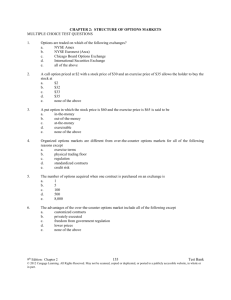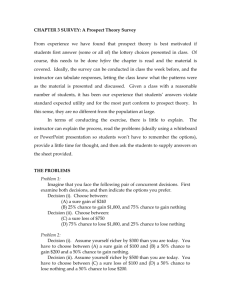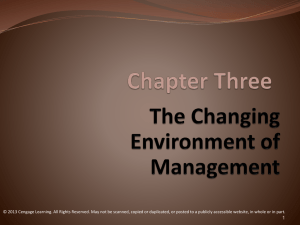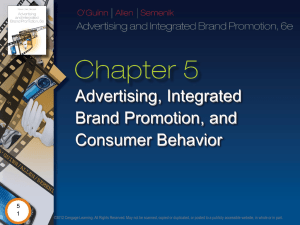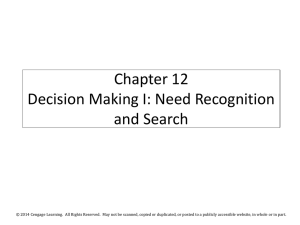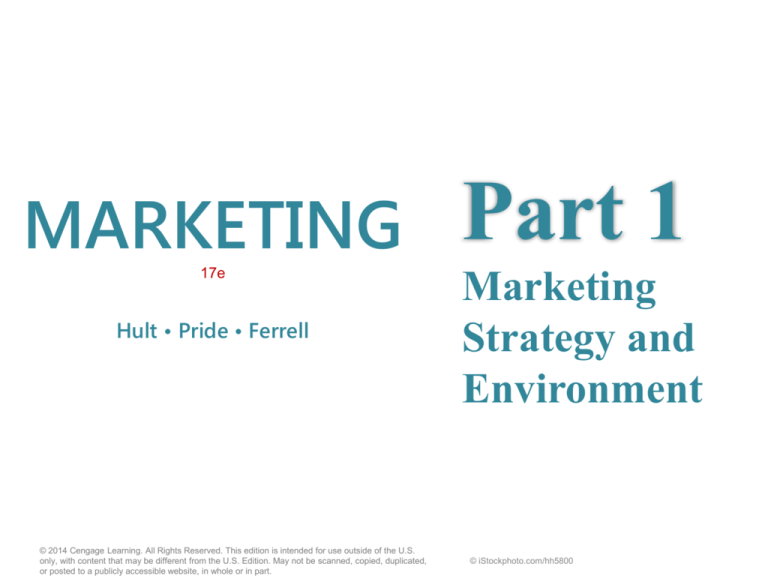
MARKETING
17e
Hult • Pride • Ferrell
© 2014 Cengage Learning. All Rights Reserved. This edition is intended for use outside of the U.S.
only, with content that may be different from the U.S. Edition. May not be scanned, copied, duplicated,
or posted to a publicly accessible website, in whole or in part.
Part 1
Marketing
Strategy and
Environment
© iStockphoto.com/hh5800
1: Strategic Marketing
Management
2: Developing and Implementing
Marketing Strategies
3: The Global Marketing
Environment
© 2014 Cengage Learning. All Rights Reserved. This edition is intended for use outside of the U.S.
only, with content that may be different from the U.S. Edition. May not be scanned, copied, duplicated,
or posted to a publicly accessible website, in whole or in part.
© iStockphoto.com/hh5800
3-2
Objectives
To recognize the importance of environmental scanning
and analysis
To understand how competitive and economic factors
affect an organization’s ability to compete and a
customer’s ability and willingness to buy products
To identify the types of political forces in the marketing
environment
To understand how laws, government regulations, and
self-regulatory agencies affect marketing activities
To explore the effects of new technology on society and
on marketing activities
To analyze sociocultural issues marketers must deal
with as they make decisions
© 2014 Cengage Learning. All Rights Reserved. This edition is intended for use outside of the U.S.
only, with content that may be different from the U.S. Edition. May not be scanned, copied, duplicated,
or posted to a publicly accessible website, in whole or in part.
© iStockphoto.com/hh5800
3-3
Environmental Forces
Competitive
Political
Economic
Environmental
Forces
Legal and
Regulatory
Technological
Sociocultural
© 2014 Cengage Learning. All Rights Reserved. This edition is intended for use outside of the U.S.
only, with content that may be different from the U.S. Edition. May not be scanned, copied, duplicated,
or posted to a publicly accessible website, in whole or in part.
© iStockphoto.com/hh5800
3-4
The Marketing Environment
Environmental Scanning
The process of collecting information about forces
in the marketing environment
Environmental Analysis
The process of assessing and interpreting the
information gathered through environmental
scanning
How you deal with the information collected during
scanning
© 2014 Cengage Learning. All Rights Reserved. This edition is intended for use outside of the U.S.
only, with content that may be different from the U.S. Edition. May not be scanned, copied, duplicated,
or posted to a publicly accessible website, in whole or in part.
© iStockphoto.com/hh5800
3-5
Discussion Point
? Which of the following resources would make
a good environmental scanning tool for a
marketer?
Trade journals
Government reports
The Internet
Friends and family of the marketer
Other employees within the firm
© 2014 Cengage Learning. All Rights Reserved. This edition is intended for use outside of the U.S.
only, with content that may be different from the U.S. Edition. May not be scanned, copied, duplicated,
or posted to a publicly accessible website, in whole or in part.
© iStockphoto.com/hh5800
3-6
Responding to Environmental
Forces
Marketers take two approaches to
environmental forces:
Passive – Accepting them as uncontrollable
Proactive – Attempting to influence and shape
them
No best way to react
Depends on the organization, management,
and the situation
© 2014 Cengage Learning. All Rights Reserved. This edition is intended for use outside of the U.S.
only, with content that may be different from the U.S. Edition. May not be scanned, copied, duplicated,
or posted to a publicly accessible website, in whole or in part.
© iStockphoto.com/hh5800
3-7
Competitive Forces
Competition – Other organizations that
market products that are similar to or can be
substituted for a marketer’s products in the
same geographic area
Most firms have competition
When marketing managers define the target
market(s) their firm will serve, they establish
a set of competitors
Marketing managers must consider the type
of competitive structure in which the firm
operates
© 2014 Cengage Learning. All Rights Reserved. This edition is intended for use outside of the U.S.
only, with content that may be different from the U.S. Edition. May not be scanned, copied, duplicated,
or posted to a publicly accessible website, in whole or in part.
© iStockphoto.com/hh5800
3-8
Types of Competitors
Brand Competitors – Firms that market
products with similar features and benefits to
the same customers at similar prices
Product Competitors – Firms that compete
in the same product class but market products
with different features, benefits, and prices
Generic Competitors – Firms that provide
very different products that solve the same
problem or satisfy the same basic customer
need
Total Budget Competitors – Firms that
compete for the limited financial resources of
the same customers
© 2014 Cengage Learning. All Rights Reserved. This edition is intended for use outside of the U.S.
only, with content that may be different from the U.S. Edition. May not be scanned, copied, duplicated,
or posted to a publicly accessible website, in whole or in part.
© iStockphoto.com/hh5800
3-9
Discussion Point
? For each of the following products, identify
brand competitors, product competitors,
generic competitors, and total budget
competitors:
Chevrolet Tahoe
Levi’s jeans
Travelocity
© 2014 Cengage Learning. All Rights Reserved. This edition is intended for use outside of the U.S.
only, with content that may be different from the U.S. Edition. May not be scanned, copied, duplicated,
or posted to a publicly accessible website, in whole or in part.
© iStockphoto.com/hh5800
3-10
Competitive Structures
Monopoly
A competitive structure in which an
organization offers a product that has no
close substitutes, making that organization
the sole source of supply
Oligopoly
A competitive structure in which a few
sellers control the supply of a large
proportion of a product
© 2014 Cengage Learning. All Rights Reserved. This edition is intended for use outside of the U.S.
only, with content that may be different from the U.S. Edition. May not be scanned, copied, duplicated,
or posted to a publicly accessible website, in whole or in part.
© iStockphoto.com/hh5800
3-11
Competitive Structures
Monopolistic Competition
A competitive structure in which a firm has
many potential competitors and tries to
develop a marketing strategy to differentiate
its product
Pure Competition
A market structure characterized by an
extremely large number of sellers, none
strong enough to significantly influence price
or supply
Does not exist in the real world, although
some industries come close
© 2014 Cengage Learning. All Rights Reserved. This edition is intended for use outside of the U.S.
only, with content that may be different from the U.S. Edition. May not be scanned, copied, duplicated,
or posted to a publicly accessible website, in whole or in part.
© iStockphoto.com/hh5800
3-12
Selected Characteristics of
Competitive Structures
© 2014 Cengage Learning. All Rights Reserved. This edition is intended for use outside of the U.S.
only, with content that may be different from the U.S. Edition. May not be scanned, copied, duplicated,
or posted to a publicly accessible website, in whole or in part.
© iStockphoto.com/hh5800
3-13
Monitoring Competition
Helps determine competitor’s strategies and
their effects on firm’s own strategies
Guides development of competitive
advantage and adjusting firm’s strategy
Provides ongoing information about
competitors
Information about competitors allows
marketing managers to assess the
performance of their own marketing efforts
and to recognize the strengths and
weaknesses in their own marketing
strategies
© 2014 Cengage Learning. All Rights Reserved. This edition is intended for use outside of the U.S.
only, with content that may be different from the U.S. Edition. May not be scanned, copied, duplicated,
or posted to a publicly accessible website, in whole or in part.
© iStockphoto.com/hh5800
3-14
Discussion Point
Monitoring competition is an essential activity
related to marketing. Some problems can
arise, however.
? What are some of the ethical issues that
emerge when managing competitive
intelligence?
© 2014 Cengage Learning. All Rights Reserved. This edition is intended for use outside of the U.S.
only, with content that may be different from the U.S. Edition. May not be scanned, copied, duplicated,
or posted to a publicly accessible website, in whole or in part.
© iStockphoto.com/hh5800
3-15
The Business Cycle
A pattern of economic fluctuations that has
four stages:
Prosperity – Low unemployment and
relatively high total income, which together
ensure high buying power (provided the
inflation rate stays low)
Recession – Unemployment rises and total
buying power declines, stifling both
consumer and business spending
© 2014 Cengage Learning. All Rights Reserved. This edition is intended for use outside of the U.S.
only, with content that may be different from the U.S. Edition. May not be scanned, copied, duplicated,
or posted to a publicly accessible website, in whole or in part.
© iStockphoto.com/hh5800
3-16
The Business Cycle
Depression – Unemployment is extremely
high, wages are very low, total disposable
income is at a minimum, and consumers lack
confidence in the economy
Recovery – The economy moves from
depression or recession to prosperity
Difficult to ascertain how quickly and to
what level prosperity will return
Maintain as much flexibility in marketing
strategies as possible to allow for any
needed adjustments
© 2014 Cengage Learning. All Rights Reserved. This edition is intended for use outside of the U.S.
only, with content that may be different from the U.S. Edition. May not be scanned, copied, duplicated,
or posted to a publicly accessible website, in whole or in part.
© iStockphoto.com/hh5800
3-17
Buying Power and Income
Buying Power – Resources, such as
money, goods, and services, that can be
traded in an exchange
Income – For an individual, the amount of
money received through wages, rents,
investments, pensions, and subsidy
payments for a given period
Disposable Income – After-tax income
Discretionary Income – Disposable income
available for spending and saving after an
individual has purchased the basic
necessities of food, clothing, and shelter
© 2014 Cengage Learning. All Rights Reserved. This edition is intended for use outside of the U.S.
only, with content that may be different from the U.S. Edition. May not be scanned, copied, duplicated,
or posted to a publicly accessible website, in whole or in part.
© iStockphoto.com/hh5800
3-18
Discussion Point
? What kind of income
do consumers
generally use to
purchase tickets to
Broadway shows?
? How does this type
of income affect
consumer buying
power?
© 2014 Cengage Learning. All Rights Reserved. This edition is intended for use outside of the U.S.
only, with content that may be different from the U.S. Edition. May not be scanned, copied, duplicated,
or posted to a publicly accessible website, in whole or in part.
© iStockphoto.com/hh5800
3-19
Credit
Credit enables people to spend future
income now or in the near future
Credit increases current buying power at the
expense of future buying power
Factors affecting credit use:
Must be available
Interest rates
Credit terms (such as size of down payment
and amount and number of monthly
payments)
© 2014 Cengage Learning. All Rights Reserved. This edition is intended for use outside of the U.S.
only, with content that may be different from the U.S. Edition. May not be scanned, copied, duplicated,
or posted to a publicly accessible website, in whole or in part.
© iStockphoto.com/hh5800
3-20
Wealth
The accumulation of past income, natural
resources, and financial resources
Global wealth is increasing
Like income, wealth is unevenly distributed
As people become wealthier, they gain
buying power:
To make current purchases
To generate income
To acquire large amounts of credit
© 2014 Cengage Learning. All Rights Reserved. This edition is intended for use outside of the U.S.
only, with content that may be different from the U.S. Edition. May not be scanned, copied, duplicated,
or posted to a publicly accessible website, in whole or in part.
© iStockphoto.com/hh5800
3-21
Willingness to Spend
An inclination to buy because of expected
satisfaction from a product, influenced by
the ability to buy and numerous
psychological and social forces
Factors that affect consumers’ general
willingness to spend:
Expectations about future employment
Income levels
Prices
Family size
General economic conditions
© 2014 Cengage Learning. All Rights Reserved. This edition is intended for use outside of the U.S.
only, with content that may be different from the U.S. Edition. May not be scanned, copied, duplicated,
or posted to a publicly accessible website, in whole or in part.
© iStockphoto.com/hh5800
3-22
American Customer
Satisfaction Index
© 2014 Cengage Learning. All Rights Reserved. This edition is intended for use outside of the U.S.
only, with content that may be different from the U.S. Edition. May not be scanned, copied, duplicated,
or posted to a publicly accessible website, in whole or in part.
© iStockphoto.com/hh5800
3-23
Political Forces
Enactment of legislation
Legal decisions interpreted by courts
through civil and criminal cases
Influence of regulatory agencies
Marketers may:
View political forces as beyond their control
and simply adjust to conditions that arise
Influence the process through contributions
and lobbying
© 2014 Cengage Learning. All Rights Reserved. This edition is intended for use outside of the U.S.
only, with content that may be different from the U.S. Edition. May not be scanned, copied, duplicated,
or posted to a publicly accessible website, in whole or in part.
© iStockphoto.com/hh5800
3-24
Legal and Regulatory Forces
Procompetitive
Legislation
SelfRegulatory
Forces
Legal and
Regulatory
Forces
Regulatory
Agencies
© 2014 Cengage Learning. All Rights Reserved. This edition is intended for use outside of the U.S.
only, with content that may be different from the U.S. Edition. May not be scanned, copied, duplicated,
or posted to a publicly accessible website, in whole or in part.
Consumer
Protection
Legislation
Encouraging
Compliance
with Laws
and
Regulations
© iStockphoto.com/hh5800
3-25
Legislation
Procompetitive Legislation
Preserves competition
Laws have been created to prevent
businesses from gaining an unfair advantage
through bribery
Consumer Protection Legislation
Protects people from harm
Prohibits hazardous products
Requires information disclosure
Aimed at particular marketing activities
© 2014 Cengage Learning. All Rights Reserved. This edition is intended for use outside of the U.S.
only, with content that may be different from the U.S. Edition. May not be scanned, copied, duplicated,
or posted to a publicly accessible website, in whole or in part.
© iStockphoto.com/hh5800
3-26
Major Federal Laws That Affect
Marketing Decisions (1)
© 2014 Cengage Learning. All Rights Reserved. This edition is intended for use outside of the U.S.
only, with content that may be different from the U.S. Edition. May not be scanned, copied, duplicated,
or posted to a publicly accessible website, in whole or in part.
© iStockphoto.com/hh5800
3-27
Major Federal Laws That Affect
Marketing Decisions (2)
© 2014 Cengage Learning. All Rights Reserved. This edition is intended for use outside of the U.S.
only, with content that may be different from the U.S. Edition. May not be scanned, copied, duplicated,
or posted to a publicly accessible website, in whole or in part.
© iStockphoto.com/hh5800
3-28
Major Federal Laws That Affect
Marketing Decisions (3)
© 2014 Cengage Learning. All Rights Reserved. This edition is intended for use outside of the U.S.
only, with content that may be different from the U.S. Edition. May not be scanned, copied, duplicated,
or posted to a publicly accessible website, in whole or in part.
© iStockphoto.com/hh5800
3-29
Major Federal Laws That Affect
Marketing Decisions (4)
© 2014 Cengage Learning. All Rights Reserved. This edition is intended for use outside of the U.S.
only, with content that may be different from the U.S. Edition. May not be scanned, copied, duplicated,
or posted to a publicly accessible website, in whole or in part.
© iStockphoto.com/hh5800
3-30
Encouraging Compliance with
Laws
Current trend is away from legally-based
organizational compliance programs
Emphasis on providing incentives to create
ethical and responsible corporate cultures
Regulatory agencies monitor marketing
activities and may enforce some laws
© 2014 Cengage Learning. All Rights Reserved. This edition is intended for use outside of the U.S.
only, with content that may be different from the U.S. Edition. May not be scanned, copied, duplicated,
or posted to a publicly accessible website, in whole or in part.
© iStockphoto.com/hh5800
3-31
Major Federal Regulatory
Agencies
© 2014 Cengage Learning. All Rights Reserved. This edition is intended for use outside of the U.S.
only, with content that may be different from the U.S. Edition. May not be scanned, copied, duplicated,
or posted to a publicly accessible website, in whole or in part.
© iStockphoto.com/hh5800
3-32
Federal Trade Commission
(FTC)
An agency that regulates a variety of
business practices and curbs:
False advertising
Misleading pricing
Deceptive packaging and labeling
Most heavily influences marketing activities
(of all regulatory units)
Assists businesses in complying with laws
and evaluates new marketing methods
© 2014 Cengage Learning. All Rights Reserved. This edition is intended for use outside of the U.S.
only, with content that may be different from the U.S. Edition. May not be scanned, copied, duplicated,
or posted to a publicly accessible website, in whole or in part.
© iStockphoto.com/hh5800
3-33
Federal Trade Commission
Enforcement Tools
© 2014 Cengage Learning. All Rights Reserved. This edition is intended for use outside of the U.S.
only, with content that may be different from the U.S. Edition. May not be scanned, copied, duplicated,
or posted to a publicly accessible website, in whole or in part.
© iStockphoto.com/hh5800
3-34
Self-Regulatory Forces
Some businesses choose to self-regulate
Often use the help of organizations like:
Better Business Bureau (BBB) – A system of
nongovernmental, independent, local
regulatory agencies supported by local
businesses that help settle problems between
customers and specific business firms
National Advertising Review Board (NARB)
– A self-regulatory unit that considers
challenges to issues raised by the National
Advertising Division (an arm of the Council of
Better Business Bureaus) about an
advertisement
© 2014 Cengage Learning. All Rights Reserved. This edition is intended for use outside of the U.S.
only, with content that may be different from the U.S. Edition. May not be scanned, copied, duplicated,
or posted to a publicly accessible website, in whole or in part.
© iStockphoto.com/hh5800
3-35
Self-Regulatory Forces
Advantages:
Establishment and implementation are usually
less expensive
Guidelines are generally more realistic and
operational
Effective self-regulatory programs reduce the
need to expand government bureaucracy
Disadvantages:
Nonmember firms do not have to abide
Lack the tools/authority to enforce guidelines
Often less strict than those established by
government agencies
© 2014 Cengage Learning. All Rights Reserved. This edition is intended for use outside of the U.S.
only, with content that may be different from the U.S. Edition. May not be scanned, copied, duplicated,
or posted to a publicly accessible website, in whole or in part.
© iStockphoto.com/hh5800
3-36
Technological Forces
Technology
Dynamic
Change
Ability to Reach
Customers
© 2014 Cengage Learning. All Rights Reserved. This edition is intended for use outside of the U.S.
only, with content that may be different from the U.S. Edition. May not be scanned, copied, duplicated,
or posted to a publicly accessible website, in whole or in part.
© iStockphoto.com/hh5800
Self-Sustaining
Technology
3-37
Technological Forces
Technology
The application of knowledge and tools to
solve problems and perform tasks more
efficiently
Impacts of technology:
Dynamic change
Ability to reach customers
Self-sustaining in nature; spurs more
development
Rapid technological growth and change are
expected to accelerate
© 2014 Cengage Learning. All Rights Reserved. This edition is intended for use outside of the U.S.
only, with content that may be different from the U.S. Edition. May not be scanned, copied, duplicated,
or posted to a publicly accessible website, in whole or in part.
© iStockphoto.com/hh5800
3-38
Discussion Point
Impact of Technology
? How are changes in
technology creating
opportunities for
marketers to
stimulate consumer
interest?
© 2014 Cengage Learning. All Rights Reserved. This edition is intended for use outside of the U.S.
only, with content that may be different from the U.S. Edition. May not be scanned, copied, duplicated,
or posted to a publicly accessible website, in whole or in part.
© iStockphoto.com/hh5800
3-39
Impact of Technology
Mobile devices and consumers’ increasing
use of the Internet have changed:
How people communicate
How marketers reach consumers
Technology can improve productivity
Expanding opportunities for e-commerce
Negative impacts of technology include:
Concerns over privacy
Intellectual property protection issues
© 2014 Cengage Learning. All Rights Reserved. This edition is intended for use outside of the U.S.
only, with content that may be different from the U.S. Edition. May not be scanned, copied, duplicated,
or posted to a publicly accessible website, in whole or in part.
© iStockphoto.com/hh5800
3-40
Adoption and Use of
Technology
Firms must keep up with technology to
maintain their status as market leaders
Must ensure that their technology is not
easily copied
Use a technological assessment to learn
about and attempt to foresee the effects of
new products and processes
Estimate whether benefits of adopting a
specific technology outweigh costs
© 2014 Cengage Learning. All Rights Reserved. This edition is intended for use outside of the U.S.
only, with content that may be different from the U.S. Edition. May not be scanned, copied, duplicated,
or posted to a publicly accessible website, in whole or in part.
© iStockphoto.com/hh5800
3-41
Sociocultural Forces
Demographic
and Diversity
Characteristics
Sociocultural
Forces
Cultural
Values
Consumerism
© 2014 Cengage Learning. All Rights Reserved. This edition is intended for use outside of the U.S.
only, with content that may be different from the U.S. Edition. May not be scanned, copied, duplicated,
or posted to a publicly accessible website, in whole or in part.
© iStockphoto.com/hh5800
3-42
Sociocultural Forces
The influences in a society and its culture(s)
that change people’s:
Attitudes
Beliefs
Norms
Customs
Lifestyles
Determine what, where, how, and when
people buy products
© 2014 Cengage Learning. All Rights Reserved. This edition is intended for use outside of the U.S.
only, with content that may be different from the U.S. Edition. May not be scanned, copied, duplicated,
or posted to a publicly accessible website, in whole or in part.
© iStockphoto.com/hh5800
3-43
Demographic and Diversity
Characteristics
Changes in a population’s demographic
characteristics lead to changes in how
people live and consume products
Increasing market of retired Baby Boomers
Generation Y
Growing Hispanic/Latino market in the U.S.
A more diverse customer base means
marketing practices must be modified and
diversified to meet changing needs
© 2014 Cengage Learning. All Rights Reserved. This edition is intended for use outside of the U.S.
only, with content that may be different from the U.S. Edition. May not be scanned, copied, duplicated,
or posted to a publicly accessible website, in whole or in part.
© iStockphoto.com/hh5800
3-44
Multicultural Nature of the
U.S. Population
© 2014 Cengage Learning. All Rights Reserved. This edition is intended for use outside of the U.S.
only, with content that may be different from the U.S. Edition. May not be scanned, copied, duplicated,
or posted to a publicly accessible website, in whole or in part.
© iStockphoto.com/hh5800
3-45
Cultural Values
Changes in cultural values alter people’s
needs and desires for products
Health, nutrition, and exercise growing in
importance (sales of organic foods, herbs, and
herbal remedies, vitamins, and dietary
supplements have escalated)
Definition of family is changing
Children continue to be very important
Trend towards eat-out and take-out meals
Green marketing helps establish long-term
consumer relationships by maintaining,
supporting, and enhancing the natural
environment
© 2014 Cengage Learning. All Rights Reserved. This edition is intended for use outside of the U.S.
only, with content that may be different from the U.S. Edition. May not be scanned, copied, duplicated,
or posted to a publicly accessible website, in whole or in part.
© iStockphoto.com/hh5800
3-46
Consumerism
The organized efforts of individuals, groups,
and organizations to protect consumers’
rights
Lobbying government officials and agencies
Letter-writing/e-mail sending campaigns and
boycotts
The movement’s major forces are:
Individual consumer advocates
Consumer organizations and other interest
groups
Consumer education
Consumer law
© 2014 Cengage Learning. All Rights Reserved. This edition is intended for use outside of the U.S.
only, with content that may be different from the U.S. Edition. May not be scanned, copied, duplicated,
or posted to a publicly accessible website, in whole or in part.
© iStockphoto.com/hh5800
3-47





